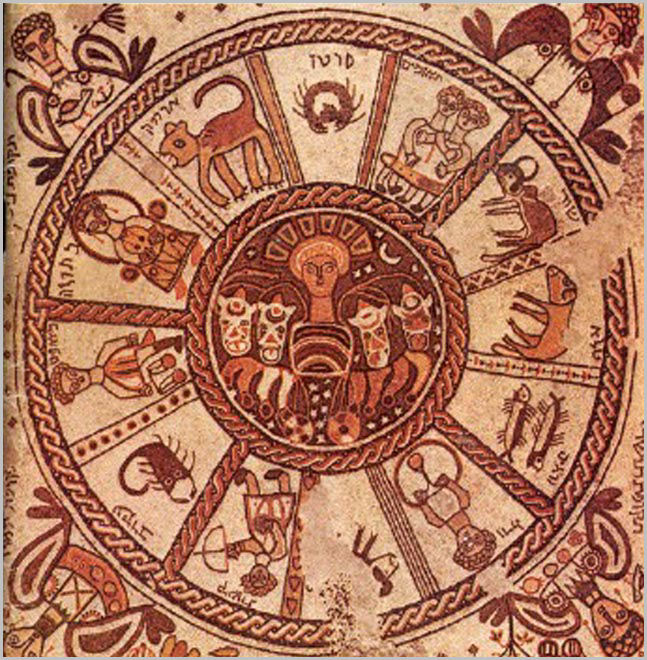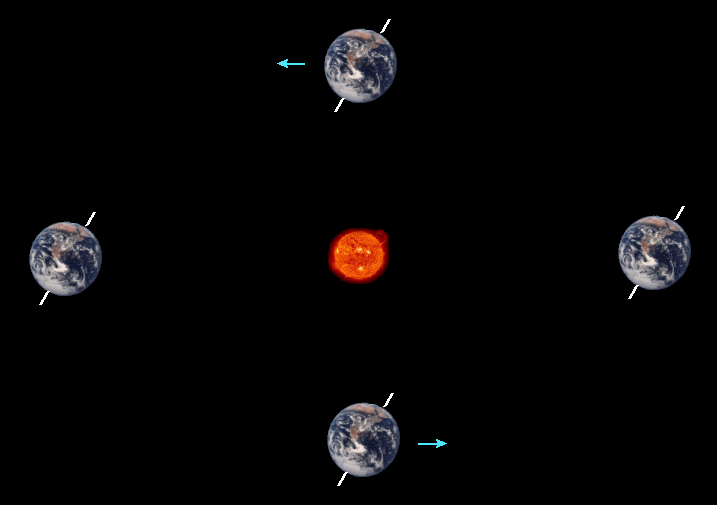
|
|


Tiled Floor Mozaic Of The Sun God Helios Surrounded By The Zodiac And The Four Seasons
Beit Alpha Synagogue, Israel - circa 550 AD

|
|


ASTROLOGY: The divination of the supposed influences of the stars and planets on human affairs and terrestrial events by their positions and aspects. - Webster's New Collegiate Dictionary.
The traditional premise of astrology is that celestial bodies emit unique energies that have varying effects on human behavior. This premise is scientifically plausible. Celestial bodies do indeed emit unique energies that travel through space/time, having varying effects on whatever they encounter, including planet Earth and its inhabitants. Some of these energies are known and their effects measurable, such as certain wavelengths of light, and certain aspects of gravity. Undoubtedly there are other, unknown energies washing over us from space, the effects of which are beyond our ability to measure.
Unless, of course, you believe in the pseudo-science/religion of astrology, which purports the knowledge and ability to predict the effects of these mysterious energies on the everyday life of human beings.
Astrological predictions are based on the positions of the stars and planets in the sky, particularly at the moment of birth. For example, a person born on August 8th is said to be born under the astrological sign of Leo, because according to the ancient charts, on that day the Sun (if you could see the stars in the daylight) would appear to be passing in front of the constellation Leo, thereby zapping this individual with a unique energy, determined by the exact positions of all the celestial bodies in the sky at that precise time.
So far so good, except for a process called precession, defined by Webster as the "gyration of the rotation axis of a spinning body." In other words, Earth does not turn perfectly on its axis. It wobbles slightly, so that over time, the positions of the stars shift in our sky. It is a slow process that takes 23,000 years to complete one cycle, and start over again. It is called the precession of the equinoxes. This process results in a gradual westward migration of all the stars in the sky, so that they are no longer where they were thousands of years ago, when the astrology charts were originally conceived. On August 8th, 2004, the Sun is no longer in the constellation of Leo, as the charts specify. It has moved over into the constellation of Cancer. Consequently, all the astrological predictions based on the Sun being in the constellation Leo, would be obsolete. Naturally, all the other predictions that are based on the positions of the Moon and planets relative to the stars would be obsolete as well.
This is where astrology breaks into two different camps: Tropical Astrology, and Sidereal Astrology. The vast majority of western astrologers belong to the Tropical camp. This camp keeps the traditional charts and tables, but abandons the traditional emphasis on the positions of celestial bodies (as well as the standard dictionary definition of astrology). This camp maintains that precession is irrelevant because the qualities of astrology are really based on the seasons, and all the references to stars and planets have always been just a convenient, symbolic way to keep track of the seasons, and the exact positions of the heavenly bodies really don't matter.
The sidereal camp does the opposite: abandoning the traditional charts and tables, but keeping the traditional precept that the exact positions of the stars and planets are critical, because that's where the energies that affect us originate. This camp creates entirely new charts and tables that reflect the effects of precession and the true positions of the heavenly bodies, relative to Earth.
The Vernal Equinox marks the point where Earth has completed exactly one fourth of its journey around the Sun. Since Earth is tilted neither towards nor away from the Sun at this time, the Sun appears directly over the equator, and days and nights are almost exactly equal all over the planet, giving us a time of equinox, which means equal nights.

It is a moment historically known as the first day of Spring, because it heralded the onset of warmer weather (in the northern hemisphere where most of the planet's population lived). It is also known as the First Point In Aries, because it was the time the Sun entered the constellation Aries. This moment marks the beginning of the astrological year, and people born at this time are said to be born under the sign of Aries.
Back in 2000 BC, when celestial observations were first formalized, the Sun was indeed in the constellation Aries during the Vernal Equinox. Thus began a 2000 year period known as the Age Of Aries. But due to precession, right around the birth of Christ the Sun began to enter the constellation Pisces on the first day of Spring, beginning the Age Of Pisces. And 200 years from now, we will be entering the long awaited Age Of Aquarius.
Astrologers put much significance on these ages, and their influence on human affairs. The Age Of Aquarius, for example, is supposed to be the age of communication and travel. It is also heralded as the age of humanitarianism. We can only hope that they are right.
The Tropic of Cancer (an imaginary line circling the globe at 23.5 degrees north latitude) was given that name because that is where the Sun is directly overhead at the moment of the summer solstice, June 22, and 2,000 years ago when the line was named, the Sun was in the constellation Cancer on that date. Now, due to precession, the Sun is actually in Taurus on June 22, but so far no-one has suggested the line be renamed The Tropic of Taurus. Besides, in approximately 20,000 years, the Sun will be right back in Cancer again anyway.
The Tropic of Capricorn is at 23.5 degrees south latitude, where the Sun is overhead on the winter solstice, December 22. Originally in the constellation Capricornus, the Sun now finds itself in Sagittarius on that date.
Since virtually everything in our solar system (except comets) generally occupies the same dimensional plane, the Sun, Moon, and planets all appear to follow the same general path across the sky. This path is called the ecliptic, and twelve of the thirteen constellations that occupy this path are called the zodiac. These are the constellations of astrology. The chart below compares the original dates of the historic twelve signs of the zodiac with the actual dates the Sun currently passes through all thirteen constellations.
| Constellation | Astrological Sign | Symbol | Tropical (obsolete) Dates | Sidereal (actual) Dates |
|---|---|---|---|---|
| Aries | Aries |  |
March 21 - April 20 | April 19 - May 13 |
| Taurus | Taurus |  |
April 21 - May21 | May 14 - June 19 |
| Gemini | Gemini |  |
May 22 - June 21 | June 20 - July 21 |
| Cancer | Cancer |  |
June 22 - July 22 | July 21 - August 9 |
| Leo | Leo |  |
July 23 - August 22 | August 10 - September 15 |
| Virgo | Virgo |  |
August 23 - September 23 | September 16 - October 30 |
| Libra | Libra |  |
September 24 - October 23 | October 31 - November 22 |
| Scorpius | Scorpio |  |
October 24 - November 22 | November 23 - November 29 |
| Ophiuchus | N/A |  |
N/A | November 30 - December 17 |
| Sagittarius | Sagittarius |  |
November 23 - December 21 | December 18 - January 18 |
| Capricornus | Capricorn |  |
December 22 - January 20 | January 19 - February 15 |
| Aquarius | Aquarius |  |
January 21 - February 19 | February 16 - March 11 |
| Pisces | Pisces |  |
February 20 - March 20 | March 12 - April 18 |
|
|